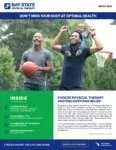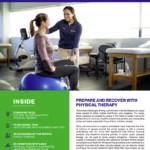Overcome Shoulder Pain with Physical Therapy
For many people, shoulder pain makes even the most mundane motions—reaching the top shelf, brushing your hair—feel impossible. And the slightest shoulder pain can have a significant impact on your life. Before your minor shoulder pain turns into a major problem, consider trying physical therapy. Since physical therapists are experts in the musculoskeletal system, they are perfectly qualified to provide medical care at the earliest stages of your pain.
Understanding the Shoulder Joint
Your shoulder is a complex network of bones, ligaments, muscles, and tendons that connect your arms to your torso.
Your rotator cuff supports your shoulder joint to allow an incredible range of motion to move, stretch, and—you guessed it—rotate. But as a “ball and socket” joint, this wide range of motion comes at the price of stability—making the shoulder vulnerable to injury.
Common Shoulder Injuries Physical Therapists Treat
Based on the nature of the injury, physical therapy at the onset of your pain (such as muscle strains) or following other medical interventions (such as fractures) can help you regain strength, mobility, and function. Some of the most common causes of shoulder pain include:
- Arthritis– Arthritis is an inflammation of the joints usually caused by ongoing wear and tear.
- Bursitis and Tendinitis– Bursas are tiny sacs filled with fluid found in joints. Excessive use of the shoulder can lead to inflammation of the bursa between the rotator cuff and your shoulder blade. Tendons are cords that connect muscle to bone. Although injury can result from an accident, tendinitis is considered an overuse injury.
- Dislocation– Occurs when the head of the upper arm bone comes partially or entirely out of the shoulder socket.
- Fracture– A shoulder fracture can refer to a break in the scapula, clavicle, or top of the humerus.
- Frozen Shoulder– Otherwise known as “adhesive capsulitis,” this is a painful shoulder joint dysfunction associated with trauma, repetitive injury, and a minimal range of motion in the shoulder.
- Rotator Cuff Injuries– The rotator cuff is a group of small muscles and tendons surrounding the ball and socket-type shoulder joint. The rotator cuff keeps the head of the humerus firmly in place within the shoulder’s shallow socket.
- Strains– With many muscles supporting the shoulder joint, muscle strains are a common injury resulting from sports injuries and work-related duties.
Physical Therapy: Your Partner in Pain Reduction
Don’t wait until your pain is unbearable before you seek treatment. Many people try to ignore the constant aches, cramps, and stiffness. But this could have detrimental consequences. Doing physical therapy right at the onset of your pain can reduce the likelihood of a more invasive approach, like surgery, and prescription pain medications like opioids.
Your physical therapist will thoroughly evaluate your medical history, previous injuries, and measurement of your strength and range of motion. Then, based on your individual goals for recreational activities or work and home duties, they’ll create a tailored treatment plan for success designed specifically for you.
What might be included in your treatment plan?
Based on your condition, medical history, stage of recovery, and personal preferences, your therapist may use some of these services during your care:
- Athletic and kinesiology taping
- Electrical stimulation (Estim)
- Dry needling
- Cupping
- Joint mobilization and stabilization
- Manual therapy techniques
- Strengthening exercises
- Stretching
Your physical therapist will also educate you on modifying your everyday activities to reduce the likelihood of re-injury. They will also provide a home exercise program to maintain your progress long after discharge from care.
Take Action Against Shoulder Pain with Physical Therapy
With so much to do, don’t let shoulder pain sideline you this spring. Call your nearest Bay State Physical Therapy clinic to jump-start your recovery today.
To schedule an evaluation, call your nearest Bay State Physical Therapy location or complete the form below.
Resources:
- https://www.pennmedicine.org/updates/blogs/musculoskeletal-and-rheumatology/2016/february/how-to-fix-shoulder-pain-without-surgery
- https://health.usnews.com/health-care/patient-advice/articles/shoulder-impingement-causes-and-treatments
Tags: Physical Therapy, shoulder pain, PT first, pt near me







